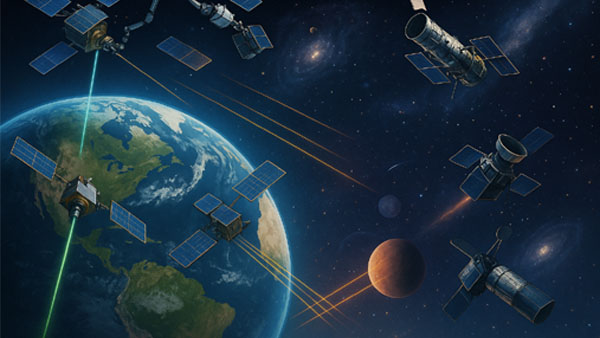By Satyabrat Borah
The National Aeronautics and Space Administration (NASA) commands a fleet of satellites orbiting Earth and venturing into deep space, showcasing technological prowess that far surpasses common perception. These marvels of engineering do more than capture breathtaking images of distant galaxies or monitor terrestrial weather; they are redefining scientific boundaries, safeguarding our planet, and unraveling the enigmatic tapestry of the cosmos. From protecting Earth’s environment to probing the origins of the universe, NASA’s satellites embody human ingenuity and curiosity. For students eager to explore the frontiers of science and technology, understanding the extraordinary capabilities of these spacecraft is essential, as they illuminate the path toward future discoveries.
Traditional assumptions about satellite communication often center on radio waves, but NASA’s cutting-edge spacecraft are embracing laser-based optical systems. These advanced technologies transmit data at speeds up to 100 times faster than conventional radio methods, delivering pristine signal quality across vast cosmic distances. By encoding information into pulses of laser light, these systems create what scientists describe as “optical highways” through space. This leap in efficiency allows high-resolution images and intricate scientific datasets to reach Earth in mere minutes, a process that once took hours. Such rapid data transfer accelerates research, enabling scientists to analyze cosmic phenomena with unprecedented speed and precision, transforming our ability to interact with the universe.
Delving into Earth’s own mysteries, NASA’s Gravity Recovery and Climate Experiment (GRACE) satellites demonstrate an almost uncanny ability to detect minute variations in the planet’s gravitational field. Capable of measuring changes as subtle as one part in a billion, these twin spacecraft effectively “weigh” different regions of Earth from orbit. This extraordinary sensitivity reveals hidden processes, such as the melting of Greenland’s ice sheets or the depletion of groundwater in arid regions, long before their effects become visible. Data from GRACE has reshaped our understanding of climate dynamics, indicating that Earth loses approximately 150 billion tons of polar ice annually. These insights are critical for predicting environmental shifts and informing strategies to mitigate climate change, underscoring the satellites’ role in planetary stewardship.
In a remarkable feat of orbital engineering, some NASA satellites maintain a geostationary orbit, appearing to hover motionless above specific points on Earth’s surface. Positioned 35,786 kilometers above the equator, these spacecraft synchronize their orbit with Earth’s rotation, enabling continuous observation of the same geographic area. Operating around the clock, they monitor weather patterns, track natural disasters, and assess atmospheric conditions. This persistent vigilance empowers meteorologists to forecast hurricanes, detect volcanic activity, and issue timely warnings for severe weather events, saving countless lives. By providing a constant stream of data, these geostationary guardians enhance our ability to respond to Earth’s dynamic and often unpredictable environment.
While space is a silent vacuum, NASA’s satellites have devised ingenious methods to “listen” to the cosmos. By detecting electromagnetic waves, solar wind interactions, and fluctuations in planetary magnetic fields, these spacecraft convert cosmic signals into audible frequencies. The resulting sounds ranging from the eerie whistles of Jupiter’s magnetosphere to the crackling bursts of solar storms are both captivating and scientifically significant. These auditory translations offer insights into space weather, helping scientists anticipate solar activity that could disrupt satellites, power grids, or communication networks on Earth. Beyond their practical applications, these cosmic symphonies evoke a sense of wonder, bridging the gap between the abstract universe and human experience.
NASA’s Transiting Exoplanet Survey Satellite (TESS) employs a deceptively simple yet powerful technique to hunt for planets beyond our solar system. By observing hundreds of thousands of stars, TESS identifies tiny dips in brightness caused by planets passing in front of their host stars. These transits, often reducing starlight by less than one percent, reveal not only the presence of exoplanets but also their size, orbital paths, and atmospheric properties. TESS has discovered thousands of potentially habitable worlds, challenging long-held assumptions about the rarity of planetary systems. This prolific planet-hunting mission expands our understanding of the galaxy’s diversity and fuels speculation about the possibility of life elsewhere, inspiring a new generation of astronomers.
Among the more surprising discoveries facilitated by NASA’s satellites is the gradual leakage of Earth’s atmosphere into space. Lightweight gases like hydrogen and helium escape from the upper atmosphere, propelled by solar radiation beyond Earth’s gravitational hold. While this process unfolds over geological timescales and poses no immediate threat, its observation provides valuable clues about long-term climate evolution. By studying atmospheric escape, scientists gain insights into how other planets, such as Mars, may have lost their atmospheres, transforming from potentially life-supporting worlds into barren landscapes. This research not only deepens our understanding of Earth’s future but also informs the search for habitable exoplanets, highlighting the interconnectedness of planetary science.
In the harsh void of space, some NASA satellites are equipped with sophisticated robotic arms and instruments capable of performing complex tasks. These mechanical systems can capture defunct satellites, remove hazardous space debris, or conduct repairs on operational spacecraft, all while hurtling through orbit at thousands of kilometers per hour. This technology addresses the growing challenge of space debris, which threatens the safety of future missions. By extending satellite lifespans and clearing orbital pathways, these robotic mechanics pave the way for sustainable space exploration. Their ability to salvage valuable equipment underscores the importance of innovation in maintaining humanity’s presence in space.
Perhaps the most profound impact of NASA’s satellites lies in their ability to rewrite the history of the cosmos. The Hubble Space Telescope, for instance, captures images of galaxies billions of light-years away, offering a glimpse into the universe’s distant past. These observations have established that the universe is approximately 13.8 billion years old and is expanding at an accelerating rate, driven by a mysterious force known as dark energy, which constitutes about 70 percent of the cosmos. This groundbreaking research, recognized with multiple Nobel Prizes, has transformed our understanding of reality itself. Each image from Hubble serves as a time machine, revealing the formation and evolution of galaxies across cosmic history and challenging humanity to contemplate its place in the universe.
The capabilities of NASA’s satellites extend far beyond their technical specifications; they represent a testament to human ambition and intellectual curiosity. For students, these spacecraft offer a window into the possibilities of science and technology, demonstrating how innovation can address both terrestrial and cosmic challenges. From laser communication systems that revolutionize data transfer to robotic systems that maintain orbital ecosystems, these satellites embody the spirit of exploration. Their discoveries whether mapping Earth’s gravitational anomalies or detecting distant exoplanets underscore the interconnectedness of our planet and the broader universe.
As humanity stands on the cusp of new spacefaring eras, NASA’s satellites continue to push the boundaries of what is possible. They protect Earth by monitoring its environment, enable communication across vast distances, and expand our knowledge of the cosmos. For students, engaging with these technologies offers not only inspiration but also a call to action. The challenges of space exploration whether mitigating climate change, managing orbital debris, or searching for extraterrestrial life require the creativity and dedication of future scientists and engineers. By studying the remarkable achievements of NASA’s satellites, young minds can envision their role in shaping the next chapter of human discovery.
In a world increasingly reliant on space-based technologies, the importance of NASA’s satellites cannot be overstated. They are more than machines; they are humanity’s eyes, ears, and hands in the cosmos, bridging the gap between our small planet and the infinite expanse beyond. As we continue to explore, these satellites will guide us, revealing truths about our universe and ourselves that we have yet to imagine.




